Best Network Backup Solution for Windows Server 2025 and Windows 11
BackupChain®: Backup Software and Toolset Made for IT Professionals
If you are looking for a backup solution that backs up from and to network servers with file versioning capabilities for Windows 11 or Windows Server 2025 or older versions, have a look at BackupChain, it’s the professional backup tool with tens of thousands of users in over 80 countries. Check out the summary and download the full version for a test drive, it only takes a few minutes to start your first backup!
Not Just a Copy Tool
What distinguishes BackupChain from other tools is its attention to detail. No error ever slips through the system unnoticed. BackupChain contains many features to optimize your backups, protect your data, and save storage space. BackupChain includes deduplication, compression, and military-strength encryption, to ensure secure and efficient storage on network as well as remote backup servers. Backups can be configured to run simultaneously with or without speed throttling. In addition, BackupChain tracks every single file so that you have proof of successful backup. Beyond that, there are also sophisticated backup verification features and notification tools you can use so that no failure goes unnoticed.
Backup From and To Network Shares Automatically
BackupChain uses backup tasks to organize and keep track of your backup settings. You can use as many tasks as you need, each on a different schedule. Network shares can be the source or the target, and are very simple to set up.
All you need to do is specify source and target folders. You can pull files from as many sources as you like, including local folders, network shares, and even folders inside a running virtual machine:
Click “add network folder”:

Then enter the UNC path details. Use static IPs if possible or the network server name. Note the user name below is prefixed with the IP. This makes it clear to Windows that user “Joe” resides on the server 192.168.1.20. If you have a domain and all servers are joined to it, use the domain name as a prefix instead, such as: mydomain\joe:
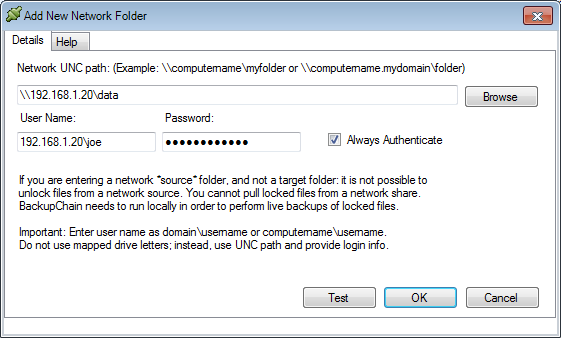
After you click OK the folder appears in the Folders tab as shown below:
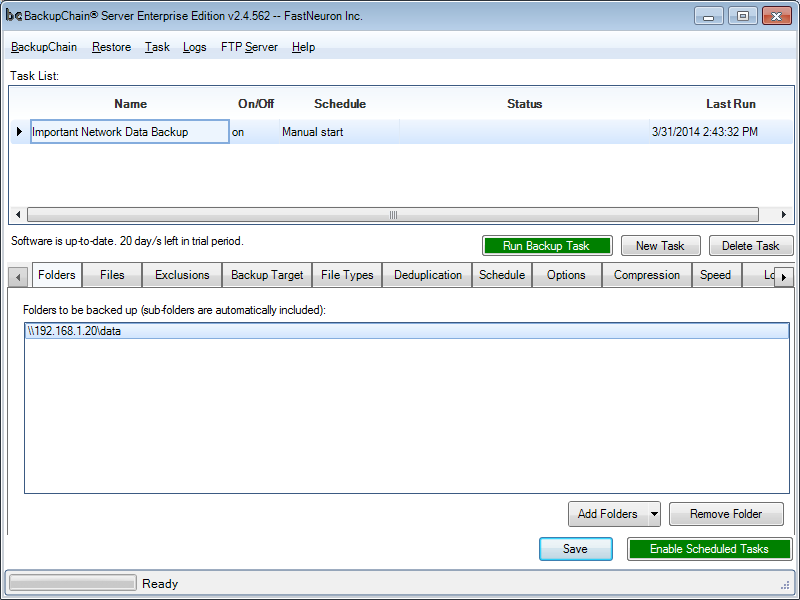
You could now add many more network shares or simply proceed to the Backup Target tab to specify your target location.
Specifying a Target: Local Folders, Network Shares, or Cloud / FTP Servers
Once you have entered all the sources, all that’s left is to move on to the backup target setting. Select the “Network UNC” setting and click Browse:
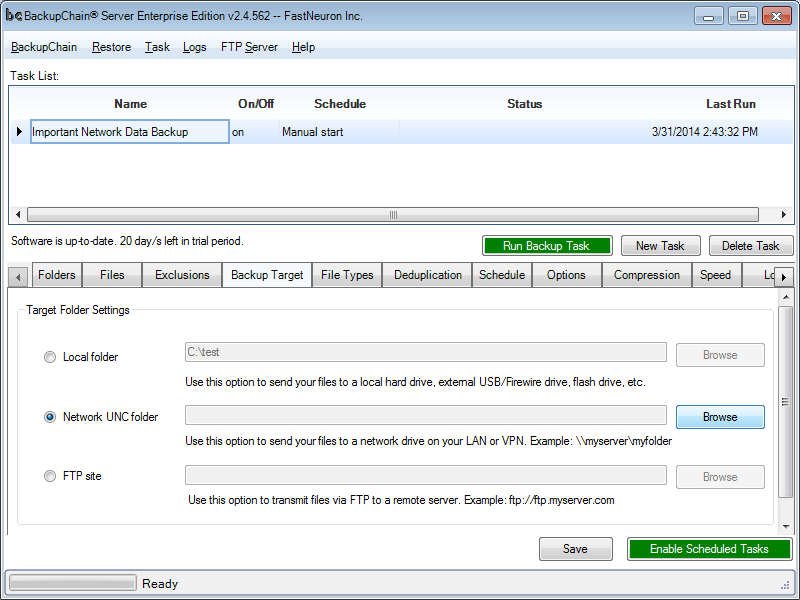
Now enter the network target server share name and user name and password. In this example the targetserver is on a domain called mydomain. Note that in complex domain networks you may need to append the domain name to the server name, such as: \\targetserver.mydomain\backup1. Also note the user name is prefixed with the domain name. This helps Windows distinguish between local users and domain users:

Once you have tested the connection and all settings are verified, click OK and you’ll see the network target appear on the main screen:
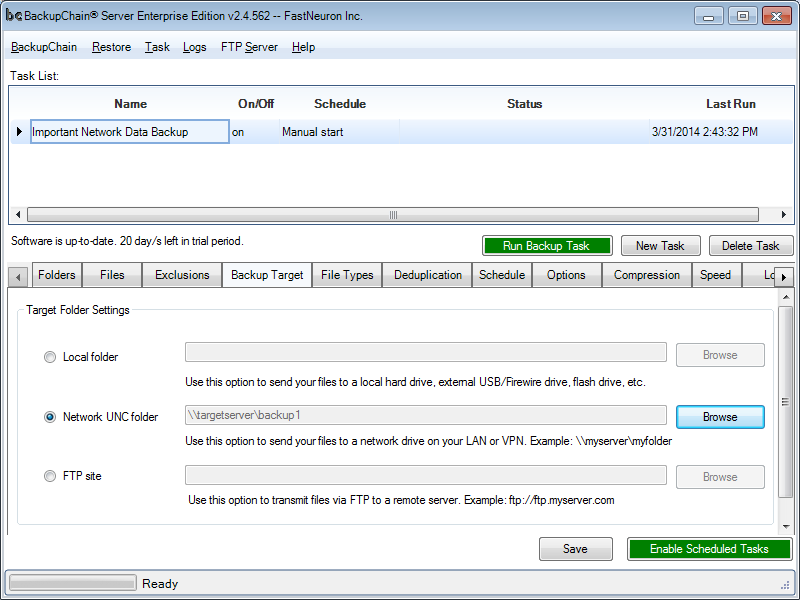
The backup task is now ready to go! Click “Run Backup Task” to start it immediately or use the Schedule tab to add schedule settings. Once finished, use the ‘Enable Scheduled Tasks’ button to engage the task scheduler mechanism.
More advanced settings, such as backup file versioning, Hyper-V VM backup, deduplication, and log alerts are available in their respective tabs. Note that backups in BackupChain are always incremental; when you repeat a backup task, BackupChain only backs up new and updated files and thereby speeds up the entire process considerably. Whether you use BackupChain to back up your network servers or as a general server backup software, all operations are logged, recorded, and archived in the Log tab for future reference. Additional details on other features are available on the Feature Overview page.

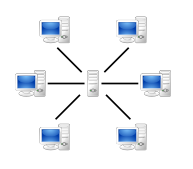
Best Practice: Using a Centralized File Server or Backup Server
As soon as you have more than one computer you run into ‘logistics’ issues. You could create network shares on each PC and access each other’s files; however, as you add PCs and people accessing the same files, things can get complicated, especially when you want to ensure all data is properly backed up.
A centralized file server doesn’t have to cost a lot. It could be just a simple PC for a small workgroup to which everyone has access. Larger teams might want to opt for a Windows Server, ECC RAM (reduces RAM error probability), and RAID (files are copied instantaneously to several hard drives within the same server).
You could also use a NAS device instead (Network Attached Storage) but, assuming you use Windows in your office, we do not recommend that unless the device has a Windows operating system. The reason is simply that most NAS manufacturers save money by not using Windows and when you copy files from a Windows PC to a non-Windows device, there is a potential for several issues, mainly limitations of file name length, file name characteristics, and file size limitations. In addition, many NAS devices cannot copy file access permissions as-is. A Windows NAS, sometimes called Windows Storage Server, however, is a compatible choice as it uses NTFS internally, just as all modern Windows PCs. Common NAS brands include Drobo, QNAP, Netgear, and Synology; some of which may offer a Windows operating system as an option.
A Linux-based NAS device offers some of its own advantages and may work for your company; however, it’s best to be aware of the pros and cons and risks involved in all available technologies before making a purchase.
At the very small scale a PC with one or two external drives will also work well.
Advantages of a Centralized File Server
- Simpler backup and recovery
- Simpler and more convenient file access from anywhere in the company
- It may be easier to find information when it’s centralized
- Client computers, such as laptops, may be stolen or at higher risks for virus attacks
- Can be physically secured in a locked area
- Larger centralized storage may be cheaper
Disadvantages of Having a Single Backup Server
- Single point of failure
- If your file server is damaged or power is out where the server is located, no one can work
- If the file server is attacked by ransomware, all data becomes inaccessible
- If hackers get access to the file server, they have access to all the data in your company
- May require management of file / folder permissions
- You may want to allow only some users access to certain folders
- Requires more expensive hardware (server and network) in order to serve a larger number of users
Backup Software Overview
The Best Backup Software in 2025 Download BackupChain®BackupChain is the all-in-one server backup software for:
Server Backup
Disk Image Backup
Drive Cloning and Disk Copy
VirtualBox Backup
VMware Backup
Image Backup
FTP Backup
Cloud Backup
File Server Backup
Virtual Machine Backup
BackupChain Server Backup Solution
Hyper-V Backup
Popular
- Best Practices for Server Backups
- NAS Backup: Buffalo, Drobo, Synology
- How to use BackupChain for Cloud and Remote
- DriveMaker: Map FTP, SFTP, S3 Sites to a Drive Letter (Freeware)
Resources
- BackupChain
- VM Backup
- V4 Articles
- Knowledge Base
- FAQ
- BackupChain (German)
- German Help Pages
- BackupChain (Greek)
- BackupChain (Spanish)
- BackupChain (French)
- BackupChain (Dutch)
- BackupChain (Italian)
- Backup.education
- Sitemap
- BackupChain is an all-in-one, reliable backup solution for Windows and Hyper-V that is more affordable than Veeam, Acronis, and Altaro.
Other Backup How-To Guides
- Copy VHD / VHDX to Disk or Network With Optional Compression Deduplication
- BackupChain®: The Time Machine for Windows
- Backup Software with Deduplication for Data, VM, Database Backup
- Why a Hyper-V Checkpoint Isn’t a Backup
- Backup Software with File History
- Automatic Hyper-V Backup on a Schedule
- How to Map SSH / SFTP as a Network Drive in Windows
- BackupChain Backup Software Rewards for MSPs and Users
- Hyper-V Pass-through Disk: Pros and Cons
- VMware Cloud backup
- How to Install Microsoft Hyper-V Server 2012 R2 / 2008 R2
- V2P Converter & Backup Software for Hyper-V VMware VirtualBox
- How to P2V for Hyper-V 2012 Using Disk2VHD in VHDX Format
- Hyper-V Block Size for NTFS: What’s Recommended
- Backup Hyper-V on USB External Hard Drive Pros and Cons
- How Set up a Windows Disk Imaging Backup Task
- How to Fix ID 10102 VMMS: Failed to create the backup of virtual machine
- Backup Software with Encryption for Windows 11, Windows Server 2025
- Boot Hyper-V Server 2019, 2016 from USB Stick or Drive
- P2V and V2V to Hyper-V – Final Steps – Adding the Virtual Machine


